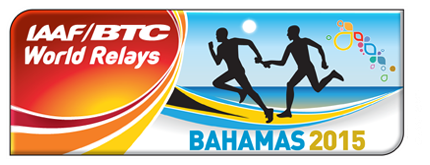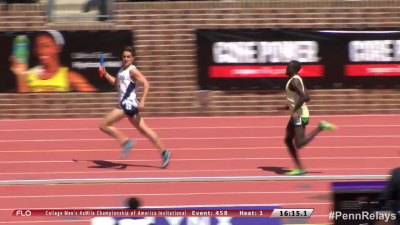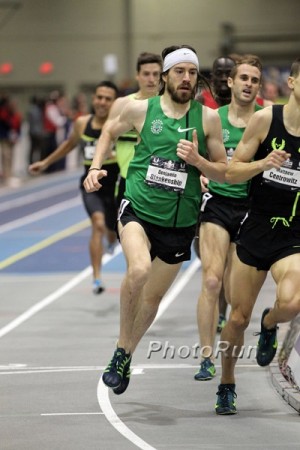2015 IAAF World Relays Men’s DMR: With No Asbel Kiprop, The U.S. Has a Shot in a Wide-Open Race
By LetsRun.com
April 30, 2015
After a pair of blowout Kenyan victories in the 4×1500 at last year’s World Relays, (the men won by 18 seconds while the women won by 20), the IAAF has scrapped the 15-lap race in favor of the shorter distance medley relay, a change that should keep the races more interesting.
In fact, this could be the most exciting race (well, at least the most exciting distance race) of the meet. With Kenyan anchor Asbel Kiprop — the two-time defending world champion at 1500 meters has a “slightly” pulled hamstring — withdrawing from the event along with teammate Ronald Kwemoi (3:28 pb), the race is now wide-open. Of the seven teams on the start line, five have a legitimate shot at the win (sorry Bahrain and Papua New Guinea).
The American team, which will likely consist of Kyle Merber (1200), Brandon Johnson (800), Ben Blankenship (1600) and a 400 runner from the 4×400 pool, certainly has a chance at a victory.
Below is the key info about this weekend’s World Relays, followed by a breakdown of the men’s DMR field.
What: 2015 IAAF World Relays
Where: Thomas Robinson Stadium, Nassau, The Bahamas
When: Saturday, May 2 – Sunday, May 3
How to watch: Live on Universal Sports Network or streaming on UniversalSports.com from 7 p.m. ET to 10 p.m. ET on Saturday and Sunday. (Sponsored: If you don’t get Universal Sports and would like to get it and BeINTV (great international soccer) and tons of international news via SlingTV, the new cut the cord service, for $10 a month on your computer, laptop, phone or Roku click here for more info on World Relays on Universal/Sling. You can even get ESPN/CNN and a ton others for $25 a month.)
Prize money:
1st: $50,000
2nd: $30,000
3rd: $20,000
4th: $12,000
5th: $10,000
6th: $8,000
7th: $6,000
8th: $4,000
World record bonus: $50,000
Full entries, with top teams below
| KENYA | ||
| Name | PBs | 2014/2015 SBs |
| Ferguson Cheruiyot Rotich | 1:42/2:16 (1k) | 1:42/2:16 (1k) |
| Abednego Chesebe | 1:45/3:35 | 1:47/3:36 |
| Joseph Poghishio | 47.4 | 47.4 |
| Timothy Cheruiyot | 1:45/3:36 | 1:45/3:36 |
| USA | ||
| Name | PBs | 2014/2015 SBs |
| Ben Blankenship | 1:48/3:35 | 3:35 |
| Mac Fleet | 1:46/2:21/3:38 | 1:50/2:21/3:38 |
| Brandon Johnson | 46.34/1:43 | 1:46 |
| Will Leer | 1:47/2:20/3:34 | 1:49/3:34 |
| Kyle Merber | 1:47/2:19/3:35 | 1:47/2:19/3:38 |
| AUSTRALIA | ||
| Name | PBs | 2014/2015 SBs |
| Samuel Baird | 46.78 | 46.78 |
| Collis Birmingham | 1:50/3:35 | 3:54 mile |
| Ryan Gregson | 1:46/3:31 | 1:46/3:36 |
| Joshua Ralph | 46.34/1:45 | 46.63/1:45 |
| Jared West | 1:46 | 1:46 |
| Jordan Williamsz | 1:46/2:19/3:36 | 1:46/2:19/3:39 |
| POLAND | ||
| Name | PBs | 2014/2015 SBs |
| Mateusz Demczyszak | 1:49/2:22/3:36 | 2:23/3:41 |
| Kamil Gurdak | 1:18 (600)/1:47/2:24 | 1:18 (600)/1:47/2:24 |
| Lukasz Krawczuk | 45.65 | 45.65 |
| Adam Kszczot | 1:14/1:43/2:15 | 1:14/1:44/2:15 |
| Marcin Lewandowski | 1:43/2:15/3:37 | 1:44/2:15/3:38 |
| Rafal Omelko | 45.66 | 45.66 |
| GERMANY | ||
| Name | PBs | 2014/2015 SBs |
| Georg Fleischhauer | 47.7 | 50.37 (400 hurdles) |
| Sebastian Keiner | 1:45/3:37 | 1:48/3:42 |
| Florian Orth | 1:47/3:34 | 1:47/3:34 |
| Robin Schembera | 1:45 | 1:46 |
| Homiyu Tesfaye | 1:46/2:17/3:31 | 1:47/2:17/3:31 |
| BAHRAIN | ||
| Name | PBs | 2014/2015 SBs |
| Abbas Abubaker Abbas | 45.17 | 45.17 |
| Yusuf Saad Kamel | 1:42/2:14/3:31 | 1:49/3:46 |
| Abraham Rotich | 1:43 | 1:46 |
| Benson Seurei | 1:45/2:16/3:31 | 1:49/3:34 |
Men’s DMR (Sunday, 8:31 p.m. ET)
While the absences of Kiprop and Kwemoi are regrettable (especially if you’re Kenyan), they could end up being a blessing in disguise. With those two plus 1:42 man Ferguson Rotich, Kenya would have been nearly impossible to beat. Kenya still has a decent squad, but they’re no longer overwhelming favorites, merely one of several teams that could win it.
One team we wish were here is Ethiopia. With 2013 World 800 champ Mo Aman, 1:44/3:29 man Aman Wote and 1:46/3:31 man Mekonnen Gebremedhin, the Ethiopians would have been a formidable opponent, and likely the favorites at full strength (they have a 400 runner, Kenenisa Hailu, who has run 46.54 this year, which would be fast enough to keep them in contention). Sadly, after sending a men’s 4×1500 team last year, Ethiopia decided not to send anyone to the Bahamas this time around.
The U.S. has the same issue with its entry as we pointed out in our women’s preview (the provisional entries don’t list a 400 runner on the U.S. DMR team) but assuming they use one of the six men listed on the 4×400 squad, the Americans should be in position to contend for the win. It’s very difficult to project how the race will play out, however, because we don’t know the specific lineups for the other countries. Each team will obviously put its strongest miler on the anchor leg, but where they deploy their remaining resources will be very interesting. Do Poland and Kenya try and get an extra lap out of 800 studs Rotich and Adam Kszczot and hope one of them can break things open on the 1200 leg? Or do they put their faith in their first two legs to maintain contact and then use Rotich/Kszczot to really open a gap on the 800 leg? Does Australia save Jordy Williamsz, fresh off slaying Edward Cheserek in the Penn Relays 4xmile, for the anchor leg and hope he can use his 1:46 speed at the end of the race? Or does it use Williamsz earlier and put Ryan Gregson, who has a much better pb than Williamsz, on anchor? How will Poland and Australia fare if several of their runners are forced to double back from the 4×800 the day before?
Unfortunately, we can’t really answer those questions as those decisions are up to the coaching staffs. But what we can do is map out the best-case scenario for each team, which we’ll do below.
Best-case scenarios
Kenya
Rotich, who ran 1:42 last year but was just third in the second heat at the Kenyan World Relays trials in 1:47.0 (hand-timed), returns to his 2014 form and breaks open the race on either the 1200 or 800 leg. His teammates defend the lead for either Timothy Cheruiyot (3:36 pb) or Abednego Chesebe (3:35 pb), who has enough of a gap on the anchor to hold off the rest of the field.
Australia
The Aussies don’t have any guy that could really dominate on his leg (yes, Williamsz ran like a stud at Penn but that was against college kids, not professionals; yes Gregson has a 3:31 pb but that dates to 2010 and he didn’t win the Aussie nationals) so it’s hard to imagine them running away from the field. Their best shot at victory is likely an honest pace throughout, which will eliminate a couple of the weaker teams but should keep the Aussies in contention with solid performances on the first three legs. From there, it’s up to Gregson or Williamsz to outkick everyone on the anchor leg.
Aussie fans, we have a question for you. Where is Jeff Riseley? Why isn’t he in the Bahamas? In March, he became the first man to win the 800 and 1500 at the Australian champs in 24 years. You could use him here. If you know what he’s up to, please email us and we’ll update this section.
Update: Riseley is a reader of LetsRun and he read this and sent us the following note:
Hey Guys,
Poland
Poland’s best shot at victory may be in the 4×800 the night before, and with as many as three guys doubling back from that event, winning the DMR could be a challenge. The best-case scenario would see Mateusz Demczyszak or Kamil Gurdak keeping it close on the 1200 leg, the Poles picking up some ground on everyone except the U.S. on the 400 (with either Lukasz Krawczuk or Rafal Omelko, both of whom ran in the 45.6s last year) and Kszczot breaking it open on the 800 leg, creating a cushion for Marcin Lewandowski on anchor. Lewandowski is an 800 specialist (he was 4th at the last two World Champs and has run 1:43) but he ran 3:37 for 1500 last year and should be capable of a decent 1600 leg. Plus, anchor legs, as we saw at Penn last week, are often tactical, particularly if it’s windy and 17 mph winds are in the forecast. Lewandowski has 1:43.79 speed so the others better make it honest.
Germany
Germany is secretly very dangerous in this race, as it can throw out 3:34 man Florian Orth on the 1200 leg, 1:45 man Robin Schembera on the 800 leg and 3:31 man Homiyu Tesfaye on anchor. If it can survive the 400 leg without losing too much ground, they can potentially win in several different styles of races as one could argue Tesfaye is quite possibly the best anchor in the field as he ran 3:34 indoors, fastest in the world this year. Right now, the 400 leg is slated to be manned by 400 hurdler Georg Fleischhauer, whose open 400 pb is just 47.70.
If Germany follows the U.S. route of subbing in a runner from the 4×400, it could improve its chances. The problem is, the B final of the 4×400 starts just 26 minutes after the men’s DMR and the main final one hour, 15 minutes after the DMR. If Germany qualifies for either final, the DMR squad would likely have to settle for the fifth-best 4×400 guy, which wouldn’t be much of an upgrade from Fleischhauer. If Germany doesn’t make either 4×400 final, the DMR could use Kamghe Gaba, the country’s best 400 runner, who ran 45.63 last year (he had the top eight German times on the year).
USA
The U.S. will likely have the best 400 leg on the field, so if Merber can hand off near the front, they should be able to give Johnson a lead to work with. Johnson, who ran 1:46.90 at Mt. SAC last weekend, is a bit of a wild card. Two years ago, he ran 1:43 and made Worlds; last year, he split just 1:48.1 on the 4×800 at World Relays, the slowest U.S. leg. If he can build on the 400 leg’s lead and deliver Blankenship a cushion of a few seconds, the U.S.’s will have a decent chance to win. Even if the first three legs can get Blankenship close to the lead, the U.S. will have a decent shot as long as they’re far enough ahead of Germany and Tesfaye.
Anchors away
DMRs frequently come down to which team has the best anchor leg, and having a great anchor is especially important in a close race, which this figures to be. So let’s look at the potential anchors for each of the contenders.
Kenya
Timothy Cheruiyot — The 19-year-old ran 3:36.3 in Kenya two weeks ago to win the Kenyan trials. Has never raced outside of Kenya.
Australia
Ryan Gregson — 3:31 pb from 2010, but hasn’t broken 3:35 since 2012 but he got his 2015 season off to a great start with a 3:36.51 win on March 14th. Second in Australian Champs 1500 behind Jeff Riseley.
OR
Jordy Williamsz — 3:36 pb. Ran 3:39 two weeks ago at Princeton, anchored Villanova 4xmile to victory at Penn Relays (also anchored Nova to second in DMR and ran great third leg on 4×800).
Poland
Marcin Lewandowski — 3:37 pb but is primarily known as an 800 runner.
Germany
Homiyu Tesfaye — 3:31 pb set last year. Ran world-leading 3:34.13 indoors in February but was only 4th at Euro Indoor Champs.
USA
Ben Blankenship — 3:35 pb set indoors (also ran 3:53 mile). Improved tremendously this year indoors. Team USA probably would certainly have a better shot with Leo Manzano or Matthew Centrowitz on anchor (neither are entered in this meet), but Blankenship had a terrific indoor season and is not a bad guy to have on the 1600 leg. He was second to Centrowitz at USA indoors in the mile (and that was after getting second the night before in the 2-mile) and has already run PRs of 3:35 (1500), 3:53 (mile) and 8:16 (2-mile) in 2015.
We do have some concerns regarding Blankenship.
1) This is Blankenship’s first race of the outdoor campaign whereas Australia’s Williamsz is in peak form now and Ryan Gregson ran 3:36 in March (Gregson last raced March 29, Blankenship on March 1). To be fair, Blankenship’s first indoor race in January was pretty good as he took down Galen Rupp at two miles.
2) Blankenship is more of a mile-3k guy than 800-mile guy and a DMR anchor leg often runs more like a 1k than it does a 3k. Blankenship’s 800 pb is just 1:48.40.
3) Blankenship has never made a major U.S. team and his only experience in a Team USA singlet came at the 2010 NACAC Under-23 Championships.
This one is really hard to predict.
DMRs come down to the anchor and every anchor seems to have a flaw. We talked about Blankenship’s above but here are the others.
Australia: Gregson’s pb is from five years ago/Williamsz is inexperienced (although wouldn’t it be fun to see him try to repeat his Penn heroics on a tactical anchor leg?).
Poland: Lewandowski is an 800 man.
Germany: While Tesfaye was the world leader indoors, he’s only 21 and has struggled recently in championship races (4th at Europeans indoors after entering with the fastest time in the world, beaten by Chris O’Hare; 5th at Euros outdoors last summer despite running 3:31 earlier in the summer) though he was 5th at Worlds in 2013.
That leaves just Kenya.
On paper, Timothy Cheruiyot is arguably the worse or next to worse anchor (his 3:36 pb is second-worst of the contenders), but we aren’t buying that argument or paying attention to his pb.
Here are some numbers for you. The kid is 19. He ran 1:45.92 last year at age 18. He just won the Kenyan trials in 3:36 at altitude. If you don’t think that’s worth something better than Blankenship’s 3:35 pb from indoors this year, then you’re crazy. Last year at this time, Ronald Kwemoi was an unknown Kenyan teen with a 3:45 pb. Now his pb is 3:28.81. It seems like there have been plenty of times we’ve seen unheralded Kenyans arrive on the scene by tearing it up at Penn Relays. We expect that to be the case here for Cheruiyot and Kenya.
Discount Kenya at your own peril (LetsRun.com co-founder Rojo is picking them for the win as long as they don’t run a 47-second guy on the quarter).
No matter what happens, it should be a fascinating race. We can’t wait to watch it unfold.
World/American records
As with the women’s race, it’s unclear exactly how fast a team will have to run to qualify for the $50,000 world record bonus. The IAAF World Relays Team Manual team manual states that:
For the Distance Medley Relay, being this a new Event, conditions for the award of a World Record Bonus are being defined and will be advised at a later stage. (Section 10.2)
Currently, the world’s best is 9:15.56 by Kenya at the 2006 Penn Relays. The splits broke down as follows:
1200: 2:50.8 (Elkanah Angwenyi)
400: 45.8 (Thomas Musembi)
800: 1:46.2 (Alfred Yego)
1600: 3:52.8 (Alex Kipchirchir)
That’s doable, but it will require a fast pace from the start and the anchors to run four hard laps rather than playing sit-and-kick. Most of all, it will require competition. When Kenya set the record in 2006, it had an American team breathing down its necks as the U.S. squad of Chris Lukezic, James Carter, Khadevis Robinson and Bernard Lagat finished just .07 of a second behind them. Two years ago, when Ethiopia came close to the record (9:16.34), they also had competition as Kenya finished just .69 of a second behind them.
For comparison’s sake, the U.S. team of Centrowitz (2:49.47), Mike Berry (46.40), Erik Sowinski (1:47.60) and Pat Casey (3:56.48) ran 9:19.93 to break the world record indoors.
| [gravityform action=”polls” id=”144″ mode=”poll” cookie=”1 month” show_results_link=”false” display_results=”true” percentages=”true” counts=”false” ajax=”true”] |
| [gravityform action=”polls” id=”145″ mode=”poll” cookie=”1 month” show_results_link=”false” display_results=”true” percentages=”true” counts=”false” ajax=”true”] |
More: We preview the other mid-d races in our 2015 IAAF World Relays section or take a trip down memory lane and re-live the 2014 IAAF World Relays Championships.



